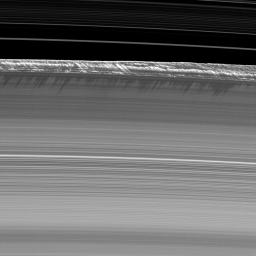The Tallest Peaks
Caption:
Vertical structures, among the tallest seen in Saturn's main rings, rise abruptly from the edge of Saturn's B ring to cast long shadows on the ring in this image taken by NASA's Cassini spacecraft two weeks before the planet's August 2009 equinox.
Part of the Cassini Division, between the B and the A rings, appears at the top of the image, showing ringlets in the inner division.
In this image, Cassini's narrow angle camera captured a 1,200-kilometer-long (750-mile-long) section arcing along the outer edge of the B ring. Here, vertical structures tower as high as 2.5 kilometers (1.6 miles) above the plane of the rings -- a significant deviation from the vertical thickness of the main A, B and C rings, which is generally only about 10 meters (about 30 feet).
Cassini scientists believe that this is one prominent region at the outer edge of the B ring where large bodies, or moonlets, up to a kilometer or more in size, are found. It is possible that these bodies significantly affect the ring material streaming past them and force the particles upward, in a "splashing" manner.
This image and others like it (see
PIA11669
) are only possible around the time of Saturn's equinox, which occurs every half-Saturn-year, or about every 15 Earth years. The illumination geometry that accompanies equinox lowers the sun's angle to the ring plane and causes structures jutting out of the plane to cast long shadows across the rings. The "season" of equinox allows shadows to appear on the rings in the months before and after equinox, but the actual equinox occurred August 11, 2009, as the sun shone directly edge-on to the ring plane.
This view looks toward the southern, sunlit side of the rings from about 32 degrees below the ring plane.
The image was taken in visible light with the Cassini spacecraft narrow-angle camera on July 26, 2009. The view was acquired at a distance of approximately 336,000 kilometers (209,000 miles) from Saturn and at a sun-Saturn-spacecraft, or phase, angle of 132 degrees. Image scale is 2 kilometers (1 mile) per pixel.
Background Info:
The Cassini-Huygens mission is a cooperative project of NASA, the European Space Agency and the Italian Space Agency. The Jet Propulsion Laboratory, a division of the California Institute of Technology in Pasadena, manages the mission for NASA's Science Mission Directorate, Washington, D.C. The Cassini orbiter and its two onboard cameras were designed, developed and assembled at JPL. The imaging operations center is based at the Space Science Institute in Boulder, Colo.
For more information about the Cassini-Huygens mission visit
http://saturn.jpl.nasa.gov/
. The Cassini imaging team homepage is at
http://ciclops.org
.
Cataloging Keywords:
| Name |
Value |
Additional Values |
| Target |
Saturn Rings |
A Ring, B Ring, C Ring, Cassini Division, Saturn |
| System |
Saturn |
|
| Target Type |
Ring |
Gap, Planet |
| Mission |
Cassini-Huygens |
|
| Instrument Host |
Cassini Orbiter |
|
| Host Type |
Orbiter |
|
| Instrument |
Imaging Science Subsystem (ISS) |
|
| Detector |
Narrow Angle Camera |
|
| Extra Keywords |
Grayscale, Moonlet, Shadow, Visual |
| Acquisition Date |
|
| Release Date |
2010-11-01 |
| Date in Caption |
2009-07-26 |
2009-08-11 |
| Image Credit |
NASA/JPL/Space Science Institute |
| Source |
photojournal.jpl.nasa.gov/catalog/PIA11668 |
| Identifier |
PIA11668 |

 Planetary Data System
Planetary Data System
